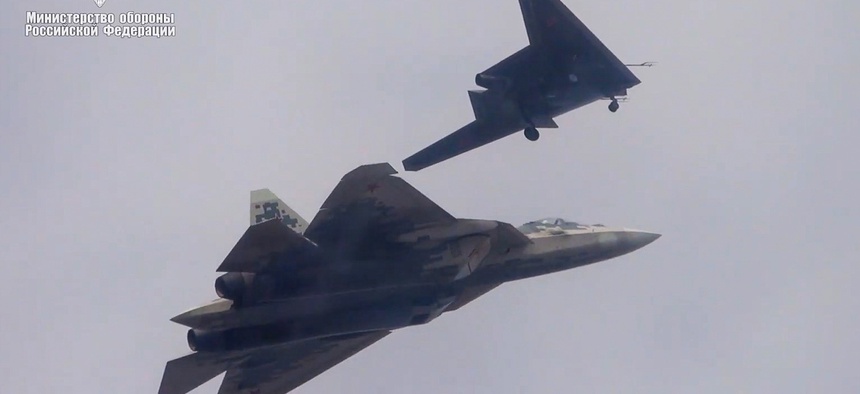Russia is working to integrate its new and advanced combat drones with manned fighter jets. The United States is not the only country that is working in this domain to pair fighter jets with heavy drones. The Defense One reported.
According to Russian news agency Izvestia, Russia is looking to bring together its advanced 5th generation Su-57 fighter jet and its S-70 Okhotnik (‘Hunter’) heavy reconnaissance and strike drone in mixed air regiments.
The Russian Su-57 is the most advanced fighter jet in the Russian fleet. Russia expects to have 76 of them by 2028, according to CNA analyst Sam Bendett. The new combat drone S-70 Okhotnik (‘Hunter’) is still under development. The two were “designed as interoperable as far as their weapons systems go, and their communications”, he further added.
France DGA selects Thales & Airbus to upgrade its SIGINT joint electronic warfare capabilities
According to the Russian Ministry of Defense, the pairing of strike drones and fighter jets is on the high priority list. Deputy Defense Minister Alexey Krivoruchko said last December that they are putting efforts to enable UAVs to operate in airspace shared with manned aircraft, to develop UAV swarms, and to add elements of artificial intelligence to UAV control systems.
According to Izvestia’s interlocutors, the new scheme radically expands the combat capabilities of the Russian aerospace forces. Integration of Su-57 and S-70 drone will close the space of hundreds and even thousands of kilometers with an impenetrable air shield. Also, fighters and stealth drones will be able to deliver high-precision strikes against important targets of a potential enemy.
Currently, the Russian military has a positive experience of pairing drones and fighter jets in aviation regiments. As Izvestia reported, the Forpost unmanned reconnaissance squadron became part of the 689th Fighter Regiment in Kaliningrad. And in Crimea, the drone unit was added to the 318th mixed air regiment.
In December last year, Sergei Chemezov, the General Director of Rostec, talked about the request from the Ministry of Defense to accelerate the production of the S-70 Okhotnik strike drone.
Andrei Yelchaninov, the first deputy chairman of the board of the Russian Military-Industrial Commission, said that the serial purchases of the S-70 would be included in the state armaments program for 2024-2033. He also spoke about the details of the joint tests of the heavy drone and Su-57 fighter jet.
Russia’s next-generation ‘Centurion’ combat suit of the future
The Russian Ministry of Defense reported one of the first flight tests of ‘Hunter’. During its test flight, it was accompanied by the prototype of the Su-57 in the air. They added, it is possible to expand the fighter’s radar field and direct its long-range missiles without the need for a manned aircraft to enter the enemy’s air defense zone.
The Ministry of Defense and the Sukhoi company signed a contract for development work to create a serial version of S-70 at the end of 2019. It is expected to be complete in 2025. The final version will have a flat engine nozzle without an afterburner. It will provide less visibility of the drone in the radar and thermal range.
The S-70 Okhotnik (the ‘Hunter’) is a heavy 20-ton unmanned combat vehicle, which is among the largest and most powerful drones in the world. Its carrying capacity and weapons bay dimensions allow it to carry any type of weapons that can also be used from Su-57 fighters.
US Marines new anti-tank weapon system
Last month Russia began testing new ‘networked warfare’ concepts to link its weapons in a battle web. Russian news outlet RIA Novosti reported.
Analysis:
The new plans of the Russian military to integrate combat drones and fighter jets will radically expand the combat capabilities of its armed forces.
Russian forces are also working to create integrated battle management from a single command and control to increase efficiency and to successfully engage the enemy targets.


